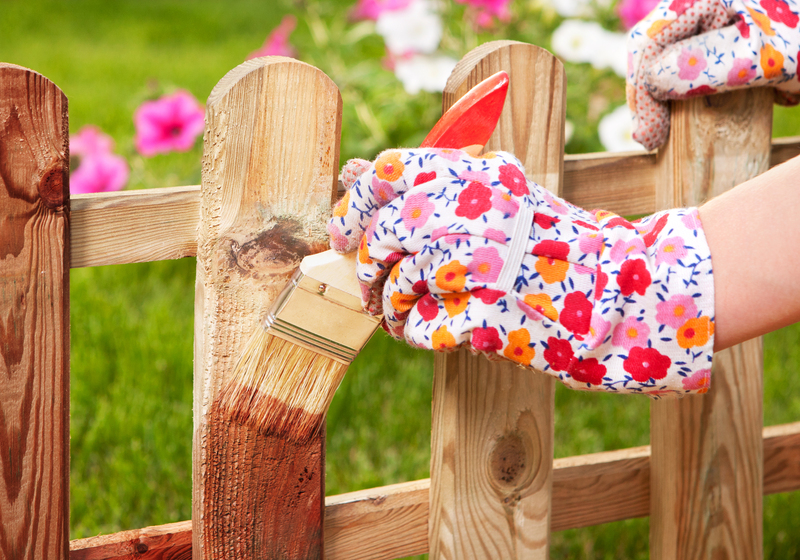Removing Tree Stumps the Smart and Safe Way in Your Garden
A tree stump in your garden can be more than just an eyesore. It can be a tripping hazard, a home for pests, and an obstacle to landscaping plans. Proper tree stump removal is crucial not only for garden aesthetics but also for the health and safety of your outdoor space. In this comprehensive guide, you'll discover smart and safe methods to remove tree stumps, essential tips, and common mistakes to avoid.
Why Bother Removing Tree Stumps?
You might wonder if it's worth the effort to remove an old tree stump. Here's why stump elimination is a landscaping best practice:
- Pest Problems: Rotting wood attracts termites, beetles, ants, and even fungi, which can spread to healthy plants or even your home.
- Tripping Hazard: Stumps and their roots can cause trips and falls, especially for children and elderly gardeners.
- Regrowth Issues: Some tree stumps sprout new shoots, making your yard look untidy and requiring frequent maintenance.
- Landscaping Limitations: Stumps get in the way of mowing, planting, or installing new features like patios, pathways, or garden beds.
- Aesthetic Value: A tree stump can diminish your garden's beauty, detracting from your carefully designed landscape.
As you can see, removing tree stumps the safe and smart way delivers both practical and visual improvements to your garden.

Understanding Different Tree Stump Removal Methods
There is no single "right" way to remove a tree stump; the smart and safe approach depends on the stump's size, location, your budget, and available equipment. Here are the most common tree stump removal options:
1. Manual Stump Removal
Manual removal is best suited for smaller stumps with shallow roots. It takes patience and muscle but avoids chemicals or heavy machinery.
What you'll need: Shovel, digging bar, mattock, hand saw or ax, heavy-duty gloves, and safety glasses.
- Step 1: Expose the Roots - Use a shovel or mattock to clear away soil from the base of the stump, exposing as much of the root system as possible.
- Step 2: Cut and Pull Roots - Slice through the roots with a saw or ax. If roots are tough, a pointed spade (root slayer) can help.
- Step 3: Remove the Stump - Wiggle and lift the stump out of the ground once roots are severed. You may need a pry bar for leverage.
Safety Tip: Wear protective gear and take frequent breaks to avoid injury and fatigue.
2. Chemical Stump Removal
For larger or older stumps, chemical methods can speed up decomposition. Here's how:
- Step 1: Drill several deep holes (about 1 inch wide) into the stump using a power drill.
- Step 2: Fill holes with a commercial stump remover or high-nitrogen fertilizer.
- Step 3: Add water to activate the chemicals, then cover the stump with a tarp to retain moisture and accelerate rotting.
- Step 4: After several weeks or months, the softened stump can be broken apart with an ax or shovel.
Caution: Read all instructions on chemical stump removers. Keep pets and children away from treated areas.
3. Stump Grinding
This method uses a powerful machine to grind the stump down below ground level. It's efficient, especially for tough or large stumps.
- Step 1: Rent a stump grinder from a garden center or hire a professional stump grinding service.
- Step 2: Wear eye, ear, and hand protection. Follow the machine's operating instructions carefully.
- Step 3: Grind away the stump, working slowly and evenly until it's several inches below the soil surface.
- Step 4: Fill the hole with compost or topsoil to level the area.
Stump grinding is the most popular stump removal technique for landscapers due to its speed and effectiveness.
4. Burning Tree Stumps
Burning is a traditional method but comes with risks and often requires permits.
- Drill holes in the stump and fill them with kerosene or fuel oil (never gasoline).
- Allow the fuel to soak for several days, then ignite the stump cautiously.
- Monitor the fire closely and douse with water once the stump is reduced to ashes.
Warning: Burning stumps may be illegal in some areas due to fire hazards. Check local regulations before attempting.
5. Natural Decomposition
If you're not in a hurry, you can let nature do the work.
Leave the stump to decompose over several years. Speed up the process with moist soil, nitrogen-rich fertilizer, or by building a compost heap over the stump.
Drawback: Natural decay is slow and may attract pests until the stump is fully gone.
Smart and Safe Stump Removal: Best Practices
Whatever method you choose for garden stump removal, following smart and safe practices will ensure good results and prevent accidents:
- Inspect the Area: Before starting, check for underground utilities, sprinkler systems, and surrounding plants. Call the local utility company if you're unsure.
- Use the Right Tools: Don't attempt stump grinding or heavy digging with poor-quality or damaged equipment.
- Protect Yourself: Wear appropriate PPE - gloves, safety glasses, sturdy footwear, and ear protection if using machinery.
- Work with a Partner: Many stump removal jobs are easier and safer with an extra pair of hands.
- Dispose of Waste Responsibly: Recycle wood chips, compost organic material, or arrange a green waste pickup service.
- Check Local Laws: Some regions have regulations about chemicals, burning, and waste disposal. Avoid fines and protect the environment by knowing the rules.
Tree Stump Removal: DIY or Hire a Professional?
Should you remove the tree stump yourself or call in the experts? The answer depends on several factors:
DIY Tree Stump Removal
- Cost-Effective: You'll typically spend less, especially for small or medium stumps.
- Learning Experience: Great for gardeners who enjoy hands-on projects and new skills.
- Time Commitment: Manual or chemical methods can take hours or even weeks. Make sure you have the patience and physical ability for the work.
Professional Stump Removal Services
- Speed and Efficiency: Pros have the expertise and machines to remove large, tough stumps quickly.
- Safety and Insurance: Avoid personal injury or property damage. Professionals are insured and know how to handle all stump situations.
- Access to Equipment: Stump grinders, excavators, and specialty tools get the job done efficiently - often within an hour.
- Disposal Included: Most services will haul away the stump grindings or leave them for you as mulch.
For very large stumps, those close to structures, or in difficult soil, hiring a specialist is the smartest and safest option.
Common Mistakes to Avoid When Removing Tree Stumps
Even the most enthusiastic gardeners can make costly or dangerous errors. Here are the top mistakes to avoid:
- Ignoring Underground Utilities: Failing to check for power, gas, or water lines can cause catastrophic damage and personal injury.
- Skipping Safety Gear: Don't risk eye, hand, or foot injuries. Always use appropriate protective equipment.
- Using Harsh Chemicals Improperly: Overuse or spills can harm your garden, wildlife, and water supply.
- Attempting to Burn When Prohibited: Burning can cause uncontrollable fires and hefty fines in restricted areas.
- Taking Shortcuts: Rushing the job leads to missed roots, incomplete removal, or damaged lawns.
Take your time, plan carefully, and use the right technique for the situation.
Reclaiming Your Garden Space: Aftercare and Creative Ideas
Once the stump is gone, what comes next? Rejuvenate your landscape with these smart ideas for your reclaimed garden space:
- Plant a New Tree or Shrub: Fill the space with a new specimen to beautify and add value to your property.
- Create a Flower Bed: Use the enriched soil from decomposition for vibrant blooms or a herb garden.
- Build a Seating Area: Install a bench, swing, or small patio for relaxation and entertaining.
- Lawn Restoration: Level the soil, add turf, and water thoroughly for a seamless grassy surface.
- Decorative Mulch: If you've ground the stump, use the chips as mulch elsewhere in your garden.
Always monitor the site for any signs of regrowth or settling and repeat the removal if needed. Proper tree stump removal means you can enjoy your garden with fewer hassles and greater beauty for years to come.
Eco-Friendly and Sustainable Stump Removal Tips
If sustainability is important to you, here are ways to minimize your environmental impact while removing garden tree stumps:
- Favor Manual and Natural Methods: These approaches reduce chemical use and energy consumption.
- Reuse or Recycle Stump Material: Turn wood chips into mulch or add chopped wood to your compost pile.
- Avoid Harmful Chemicals: Choose organic or mechanical methods when possible, especially near water sources and edible gardens.
- Plant Natives: Replace the stump with native plants that support local wildlife and require less maintenance.
- Consult Permaculture Principles: Incorporate stump grindings into swales or garden beds to boost soil fertility and carbon storage.

Frequently Asked Questions About Smart Tree Stump Removal
How long does it take for a tree stump to decompose naturally?
Most stumps take 3-7 years to decompose fully without intervention, depending on wood type, climate, and size.
Can I plant over the area after removing a stump?
Yes, but it's best to remove as much root material as possible and replace some soil to promote healthy new growth.
Is stump grinding better than manual removal?
Stump grinding is faster and more effective for large or difficult stumps, while manual removal is suitable for smaller stumps and reduces costs.
Are chemical stump removers safe for pets?
Chemical products can be hazardous; keep children and pets away from treated stumps and follow all label instructions carefully.
What if roots continue to sprout after removal?
Cut new shoots promptly, and consider additional stump removal techniques to exhaust the root system.
The Final Word: Remove Tree Stumps the Right Way
Smart and safe tree stump removal ensures a healthier, more attractive, and hazard-free garden. Whether you opt for manual digging, chemical treatment, or professional stump grinding, always put safety and environmental responsibility first. With the right approach, that stubborn stump will soon be a thing of the past, and you'll enjoy a revitalized garden ready for new projects and lasting beauty.
Ready to reclaim your landscape? Take action today, and experience the satisfaction of a stump-free, thriving garden!